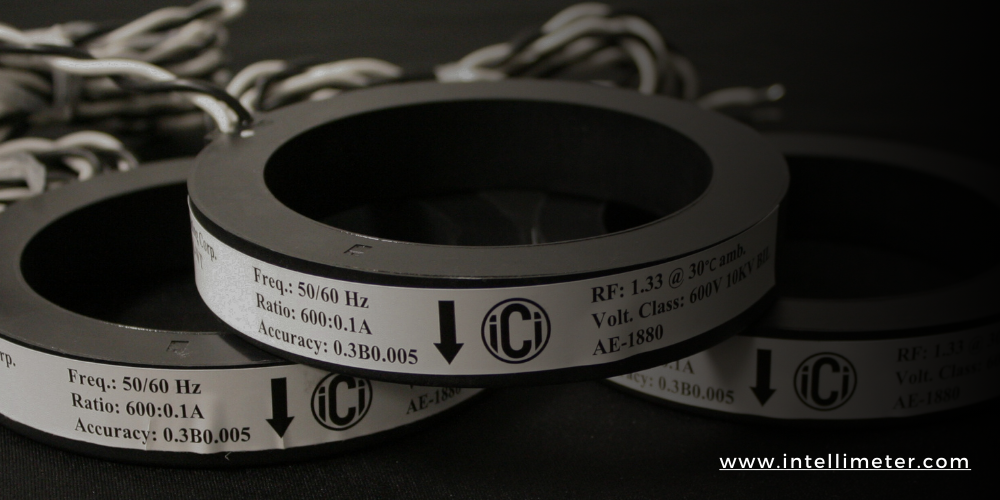This is a commonly asked question by contractors when installing an Intellimeter system.
Intellimeter’s electric meters use milliAmp secondary current transformers (CTs) which are safer because they are self-shorting and smaller in size. However, because of their small size, there are concerns with increasing the length of the leads as it can affect the accuracy and performance of the CT.
Extending the leads can introduce additional resistance and inductance which may affect the CT's ability to accurately measure current, especially at higher impedance. If you exceed the CT's current rating, accuracy can be compromised.
We recommend that the existing leads of our 0.08A and 0.1A secondary output CTs be extended no more than a total of 100 feet (30 meters) as this is considered the allowable lead extension length. Here are some general guidelines to consider:
Wire Gauge: The wire gauge (thickness) of the extended CT leads plays a crucial role. Thicker wires have lower resistance which can help maintain accuracy over longer lead lengths. It's essential to use a wire gauge appropriate for the CT's rating and the length of the extension.
For instance, the standard lead length of Intellimeter’s CTs is 6 feet. Intellimeter recommendsextending them up to a maximum of 100 feet with the same 18 AWG, twisted pair, multistranded wire. This represents adding 94 feet to each of the positive and negative CT leads or an equivalent of 188 feet.
Please refer to the resistance table provided by Philatron and to the standardized 25°C column. Bear in mind that the resistance values are for direct current (DC) and that exudes inductance and capacitance.
|
|
|
Cross-Section at 20° C |
Ohms per 1,000 Feet |
||||||
|
Gage |
Diameter |
Circular |
Square |
0° C |
15° C |
20° C |
25° C |
50° C |
75° C |
|
4/0 |
460.0 |
211 600. |
0.1662 |
0.045 16 |
0.048 05 |
0.049 01 |
0.049 98 |
0.054 79 |
0.059 61 |
|
3/0 |
469.6 |
167 800. |
0.1318 |
.056 95 |
.060 59 |
.061 80 |
.063 02 |
.069 09 |
.075 16 |
|
2/0 |
364.8 |
133 100. |
0.1045 |
.071 81 |
.076 40 |
.077 93 |
.079 47 |
.087 12 |
.094 78 |
|
0 |
324.9 |
105 500. |
.082 89 |
0.09055 |
0.09634 |
0.09827 |
0.1002 |
0.1099 |
0.1195 |
|
1 |
289.3 |
82 690. |
.065 73 |
0.1142 |
0.1215 |
0.12390 |
0.1264 |
0.1385 |
0.1507 |
|
2 |
257.6 |
66 370. |
.052 13 |
0.14400 |
0.1532 |
0.1563 |
0.1593 |
0.1747 |
0.1900 |
|
3 |
229.4 |
52 640. |
.041 34 |
0.1816 |
0.1932 |
0.1970 |
0.2009 |
0.2203 |
0.2396 |
|
4 |
204.3 |
41 740. |
.032 78 |
0.2289 |
0.2436 |
0.2485 |
0.2533 |
0.2778 |
0.3022 |
|
5 |
181.9 |
33 100. |
.026 00 |
0.2887 |
0.3072 |
0.3133 |
0.3195 |
0.3502 |
0.3810 |
|
6 |
162.0 |
26 250. |
.020 62 |
0.3640 |
0.3873 |
0.3951 |
0.4028 |
0.4416 |
0.4805 |
|
7 |
144.3 |
20 820. |
.016 35 |
0.4590 |
0.4884 |
0.4982 |
0.5080 |
0.5569 |
0.6059 |
|
8 |
128.50 |
16 510. |
.012 97 |
0.5788 |
0.6158 |
0.6282 |
0.6405 |
0.7023 |
0.7640 |
|
9 |
114.40 |
13 090. |
.010 28 |
0.7299 |
0.7766 |
0.7921 |
0.8077 |
0.8855 |
0.9633 |
|
10 |
101.9 |
10 380. |
.008 155 |
0.9203 |
0.9792 |
0.9989 |
1.018 |
1.117 |
1.215 |
|
11 |
90.74 |
8234. |
.006 467 |
1.161 |
1.235 |
1.260 |
1.284 |
1.408 |
1.532 |
|
12 |
80.81 |
6530. |
.005 129 |
1.463 |
1.557 |
1.588 |
1.619 |
1.775 |
1.931 |
|
13 |
71.96 |
5178. |
.004 067 |
1.845 |
1.963 |
2.003 |
2.042 |
2.239 |
2.436 |
|
14 |
64.08 |
4107. |
.003 225 |
2.327 |
2.476 |
2.525 |
2.575 |
2.823 |
3.071 |
|
15 |
57.07 |
3257. |
.002 558 |
2.934 |
3.122 |
3.184 |
3.247 |
3.560 |
3.873 |
|
16 |
50.82 |
2583. |
.002 028 |
3.700 |
3.937 |
4.016 |
4.094 |
4.489 |
4.884 |
|
17 |
45.26 |
2048. |
.001 609 |
4.6660 |
4.964 |
5.064 |
5.163 |
5.660 |
6.158 |
|
18 |
40.30 |
1624. |
.001 276 |
5.883 |
6.260 |
6.385 |
6.51 |
7.138 |
7.765 |
One more thing to consider is the burden resistance which refers to the impedance presented to the secondary winding of the CT. Extending the CT leads may increase the burden impedance, affecting the CT's performance.
Here are Intellimeter’s recommendations:
- If extending the CT leads using the original wire gauge, 18AWG, do not exceed 100 f
- In order to reduce the impedance and the skin effect, use a twisted pair, multistranded copper conductor. The greater number of strands, the better.
- From the table above, use the equivalent resistance of 200 feet of the 18AWG wire. On a different gauge, and as the distance increases, allow for a higher component of capacitance or use the table below:
|
Maximum length of extension in ft. recommended. |
||||
|
Gage No. |
Diameter |
Circular |
Square |
25° C |
|
10 |
101.9 |
10 380. |
.008 155 |
500 |
|
12 |
80.81 |
6530. |
.005 129 |
350 |
|
14 |
64.08 |
4107. |
.003 225 |
230 |
|
16 |
50.82 |
2583. |
.002 028 |
150 |
These values can also be used for 5 Ampere secondary current transformers.
In summary, while it is possible to extend the leads on a current transformer, it should be done carefully, taking into account the CT's rating, wire gauge, voltage drop, burden resistance, and application requirements. Call Intellimeter or consider consulting with a qualified electrical engineer to ensure that any CT lead extensions do not compromise accuracy or safety.


